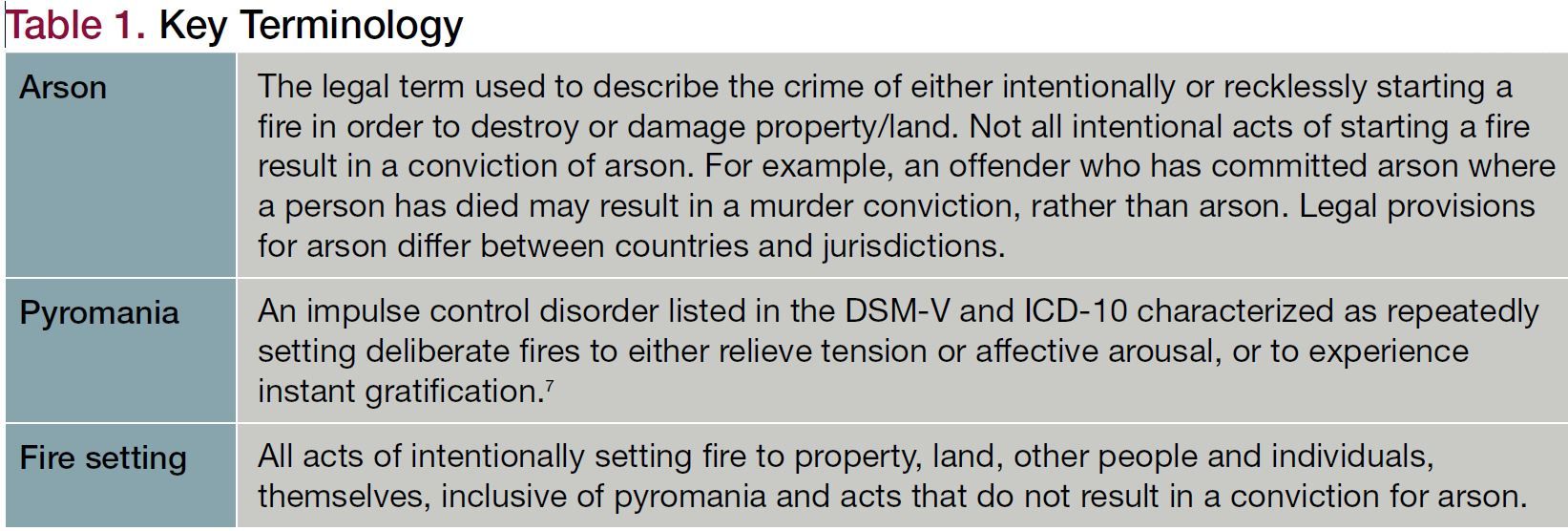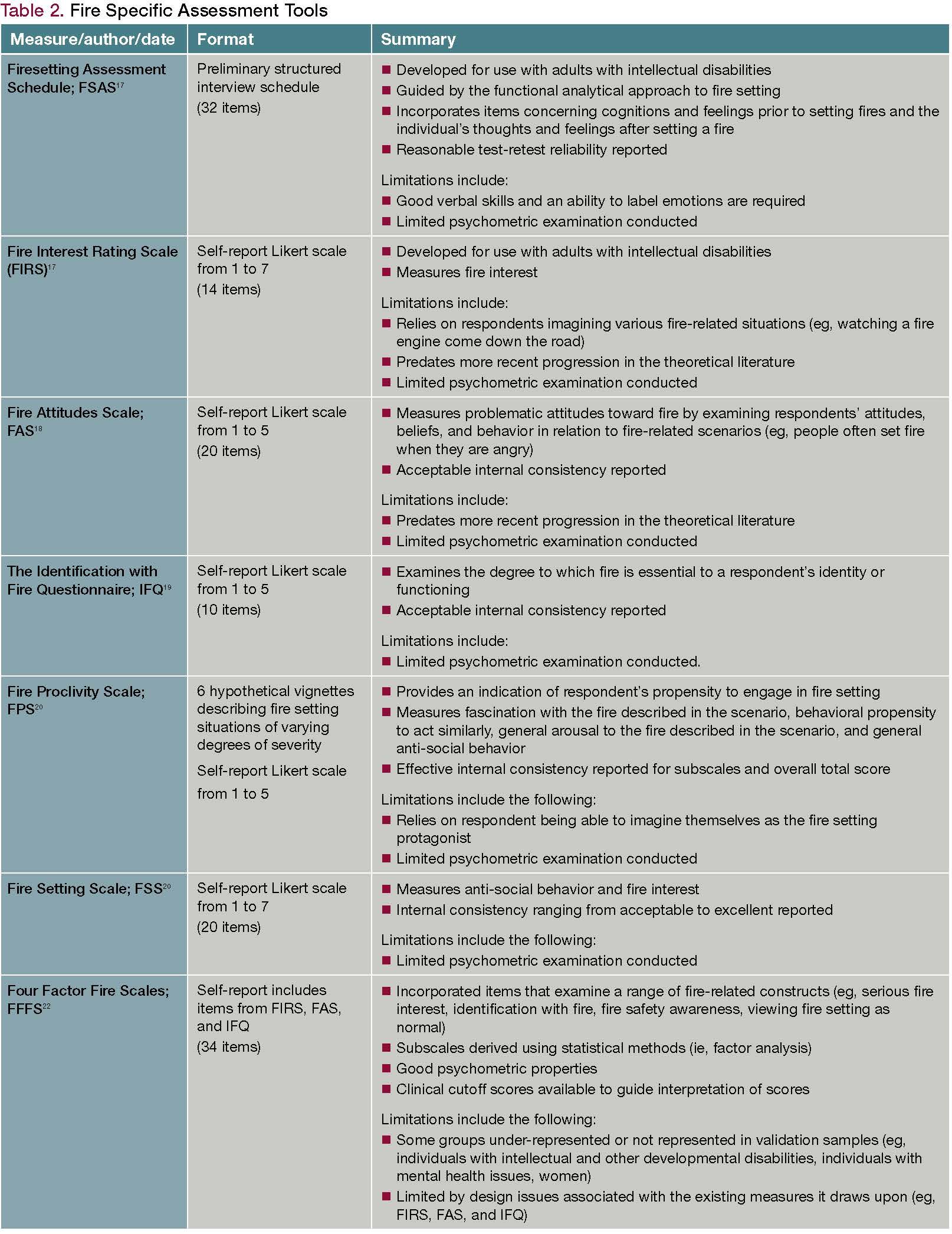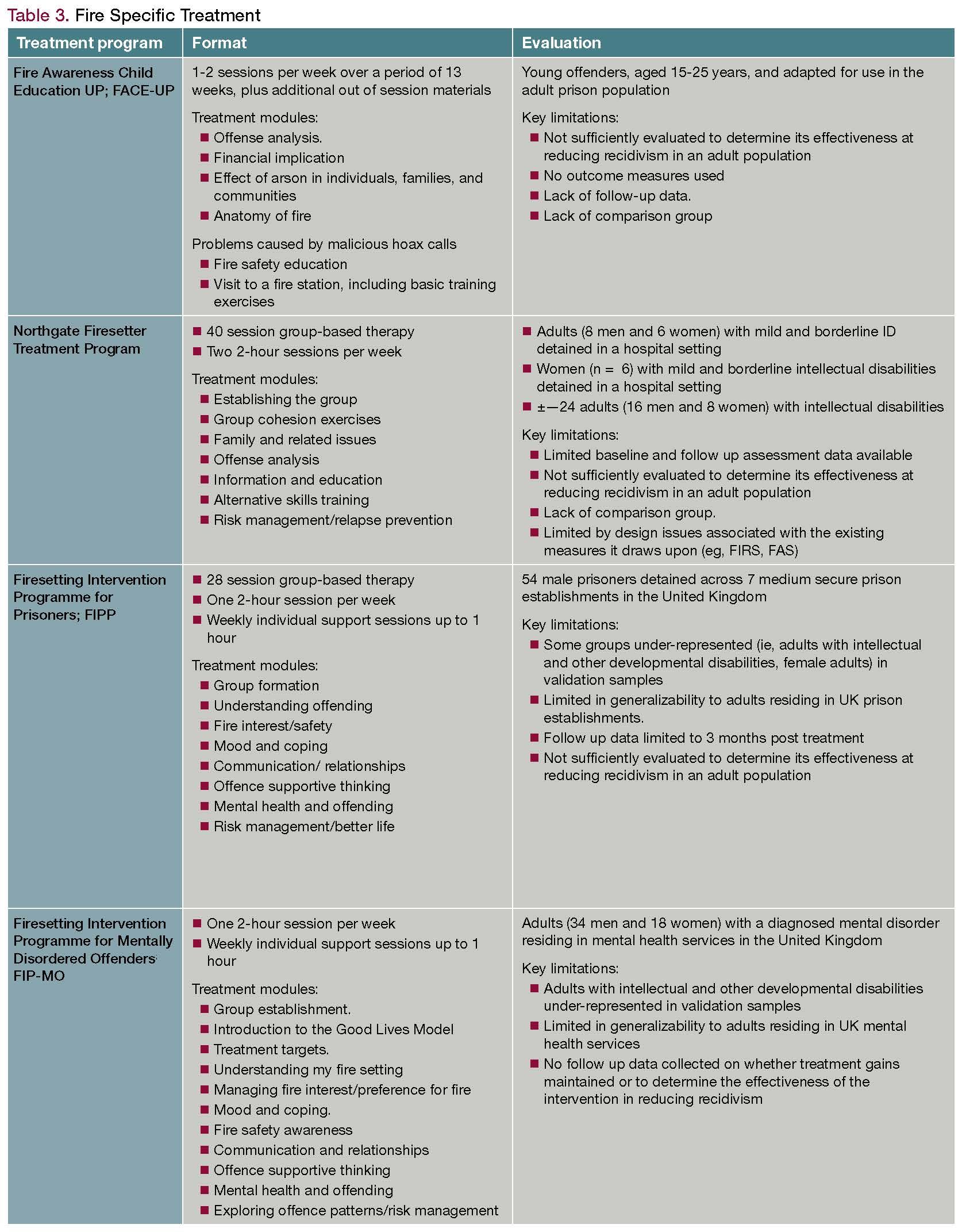Article
Understanding Adult Fire Setting, Pyromania, and Arson
Author(s):
Fire setting is the current preferred term in the literature to describe acts of deliberately started fires regardless of their legal or diagnostic status.
AshishManoharTarar/shutterstock

CLINICAL
Fire setting behavior has devastating consequences in terms of the harm caused to individuals, the damage caused to property, and the financial implications for individuals and society. Between 2010-2014, an estimated 261,330 intentional fires were reported to US municipal fire departments each year, resulting in 440 deaths, and 1310 injuries, and the economic cost of fire setting was estimated to be as high as $328.5 billion per year.1-4 In the United States, 1 in 100 adults self-reported a lifetime history of deliberate fire setting; 38% of these fire settings persisted beyond the age of 15 years.5,6 Although estimations of the number of people who set fires within a population are almost certainly imprecise due to methodological limitations such as variations in study design, definition of fire setting used, data analysis techniques, ungeneralizable samples, and response bias, they do provide insight into the scale of the problem.
Terminology
Various terminology, with somewhat different meanings, has been used within the literature to describe offending behavior that involves fire (Table 1). Although arson and pyromania are terms used to describe intentional fires set within specific contexts (eg, legal or psychiatric), fire setting is the current preferred term in the literature to describe acts of deliberately started fires regardless of their legal or diagnostic status.
Psychopathology
Comorbidity is common among adults who set fires. Common diagnoses include personality disorder, psychosis, substance dependence, and mood disorders.8 Reported prevalence rates of pyromania are relatively low, ranging between 0 to 10% of adults who set fires.9,10 Lower cognitive functioning, intellectual disabilities, and other developmental disorders (eg, autism) are also common, although exact prevalence varies widely depending upon the population sampled (ie, inpatient, community, prison samples).11
Assessment of adults
Despite the development of reliable and valid assessment tools in other areas of offending behavior (eg, sexual offending), the systematic development of tools specific to fire setting has been slower to progress. Nevertheless, several tools have been developed to support the process of systematically collecting and collating clinical information from a range of sources (eg, self and informant reports, behavioral observations, file reviews and clinical assessments) in order to formulate risk and identify treatment needs and intervention plans for individuals who set fires (eg, the Tranah Firesetting Inventory,12 Pathological Firesetters Interview,13 St Andrew’s Fire and Arson Risk Instrument,14 Northgate Firesetter Risk Assessment-2.0,15 Goal Attainment Scales16). These tools do not represent validated risk assessments for fire setting, however, a few fire-specific psychometric measures have been developed to assess fire-related factors (although they lack sufficient evaluation) (Table 2).
Most recently, the properties of the Fire Interest Rating Scale, Fire Attitudes Scale and the Identification with Fire Questionnaire were analyzed using factor analysis and 4 clinically relevant constructs identified across the 3 scales (ie, the Four Factor Fire Scales):
(1) identification with fire,
(2) serious fire interest,
(3) poor fire safety,
(4) fire setting as normal.22
However, data collected to validate these measures was limited (eg, ungeneralizable/small samples). Nevertheless, despite fire specific measures not having undergone rigorous reliability and validity evaluations, they can still be used by experienced clinicians as part of a comprehensive assessment.
Treatment of adults who set fires
Those who engage in fire setting are often complex individuals with a diverse set of treatment or intervention needs warranting a specialist approach that reduces their risk of further offending. Most specialist treatment programs are underpinned by a cognitive-behavioral approach, targeting a range of criminogenic needs and factors associated with fire setting, including cognitive distortions, poor problem solving, communication difficulties, self-regulation deficits, and relapse prevention. Treatment often includes a component on fire safety education and the consequences of fire setting, while also addressing a range of associated interpersonal problems (eg, low self-esteem, social competence difficulties, and poor goal setting). Table 3 summarizes empirically evaluated treatment programs.
Existing interventions that target fire setting behavior in adults include an adapted version of the Fire Awareness Child Education UP (FACE-UP).13 More recently, a cognitive-behavioral group-based intervention for individuals with developmental disabilities called the Northgate Firesetters Treatment program was developed.16,25,26 Investigators reported follow-up data for 24 participants (16 men, 8 women) who completed the Northgate Firesetters Treatment Programme, between 4 years and 12 years, 9 months posttreatment. The majority of participants (n = 17) were living in community settings and only 1 female participant was reported to have set a further fire, although suspicions were raised concerning another 2 participants.27 Despite these positive findings, both of these treatment programs are grounded in theoretical perspectives that predate more recent advancements in the field (ie, Functional Analysis Theory,28 Dynamic-Behavior Theory29,30). Furthermore, their effectiveness are limited in their comparability to other generic interventions, small sample sizes, and lack of robust evidence in terms of their effectiveness in reducing reoffending.
The Firesetting Intervention Programme for Prisoners (FIPP)31 and the Firesetting Intervention Programme for Mentally Disordered Offenders (FIP-MO)32 are based on the latest comprehensive theory of fire setting: the Multi-Trajectory Theory of Adult Firesetting (M-TTAF).33 The M-TTAF integrates parts of existing psychological theory that are supported by empirical evidence including psychological vulnerabilities, developmental factors, cultural factors, social learning factors, biological factors, and contextual factors related to fire setting into a detailed multifactorial theory.
Following a pilot evaluation of the FIPP, positive findings were reported posttreatment on measures related to fire interest/problematic associations with fire, offence supportive attitudes (ie, fire specific, violent, antisocial), locus of control, and anger regulation, which were stable at 3 month follow-up.34 However, the evaluation of the FIPP was conducted solely with adult males in a prison environment; thus, its effectiveness for women and adults with intellectual and developmental disabilities has yet to be established. Consequently, the FIP-MO was developed to address fire setting and fire-related risk behaviors for both men and women across secure forensic psychiatric hospitals in the United Kingdom. Significant improvements on self-reported interests, beliefs and attitudes about fire, as well as improvement in anger expression.35
It is important to note that due to the paucity of research on fire setting by adults with intellectual and developmental disabilities, the generalizability of the M-TTAF to such groups, and the interventions underpinned by it, has yet to be established. Further, despite evidence suggesting that between 0.4% to 43.6% of adults who set fires have intellectual and developmental disabilities,36,37 no treatment program to date has been rigorously evaluated for this population. Yet, there is evidence to suggest this small but important group have different characteristics and offence specific treatment needs requiring a specialized intervention.38 Nevertheless, the FIPP and FIP-MO represent the first standardized specialist interventions for individuals who deliberately set fires and have been subject to a multisite research evaluation, with results showing that they are effective in reducing some of the fire setters’ key deficits.
Prognosis
Evidence suggests general recidivism is as high as 60% among adults who set fires; reoffending with fire is much lwer with estimates between 4% and 16%.16,39,40 However, the operational definition of recidivism, study methodology, setting and sample populations vary widely. Nevertheless, recidivism has been largely associated with younger age, single relationship status, a diagnosis of personality disorder, a history of criminal offending, an interest in fire, and a number of attributes suggestive of childhood disturbance.42 Furthermore, reported length of stay in hospital for adults with intellectual and other developmental disabilities and history of fire setting vary from 950 days to 1725 days.43,44 However, very few studies have included details pertaining to length of stay, which is inevitably effected by many confounding variables, such as mental health, engagement in treatment, previous offending history that are not accounted for within the data.
Conclusions
Whilst there have been significant advancements in our understanding of deliberate fire setting in recent years, further research is urgently needed to understand the etiology of fire setting and to further develop specialist assessment and treatment protocols. In particular, little is known about the relationship between cultural factors and fire misuse, gender-specific factors, or the needs of individuals with intellectual and/or other developmental disabilities. In addition, research on factors that influence the maintenance and desistance process for fire setting will aid the construction of valid and reliable risk assessment tools and ensure individualized treatment approaches are taken and practice is evidence based. Focusing on these areas will also ensure that treatment efforts evolve to meet the needs of individuals who have set fires regardless of the treatment setting.
Ms Collins is a postgraduate researcher at the Tizard Centre, School of Social Policy, Sociology and Social Research, University of Kent, UK. Dr Tyler is a lecturer in forensic psychology at theSchool of Psychology, Victoria University of Wellington, New Zealand, and Honorary Lecturer in Forensic Psychology at the University of Kent, UK. Dr Barnoux is a chartered psychologist and lecturer in forensic psychology and intellectual and developmental disabilityat the Tizard Centre, School of Social Policy, Sociology and Social Research, University of Kent. Ms Collins and Dr Barnoux have nothing to disclose regarding this article. Dr Tyler is involved in providing training and evaluating the FIPP and FIP-MO programs and has received funding from Fire and Emergency New Zealand to conduct research on their Fire Awareness Intervention Programme (FAIP) for youth.
References
1. Home Office. Fire statistics data tables. May 14, 2020. Accessed July 23, 2020. https://www.gov.uk/government/statistical-data-sets/fire-statistics-data-tables
2. Campbell R. Intentional fires. National Fire Protection Association. July 2017. Accessed July 23, 2020. https://www.nfpa.org/News-and-Research/Data-research-and-tools/US-Fire-Problem/Intentional-fires
3. Arson Prevention Forum. State of the Nation Report 2017. Stop Arson UK. Accessed July 23, 2020. http://www.stoparsonuk.org/arson/documents/Arson-Prevention-Forum-Booklet.pdf
4. Zhuang J, Payyappalli VM, Behrendt A, Lukasiewicz K. Total cost of fire in the United States. National Fire Protection Association. October 2017. Accessed July 23, 2020. https://www.nfpa.org/News-and-Research/Data-research-and-tools/US-Fire-Problem/Total-cost-of-fire-in-the-United-States
5. Blanco C, Alegria AA, Petry NM et al. Prevalence and correlates of fire setting in the United States: results from the National Epidemiologic Survey on Alcohol and Related Conditions (NESARC). J Clin Psychiatry. 2010;71(9):1218-1225.
6. Vaughn M, Fu Q, DeLisi M, et al. Prevalence and correlates of fire setting in the United States: results from the National Epidemiological Survey on Alcohol and Related Conditions. Compr Psychiatry. 2010;51(3):217-223.
7. American Psychiatric Association. Diagnostic and Statistical Manual of Mental Disorders, DSM-V. American Psychiatric Association; 2013.
8. Bell R, Doley R, Dawson D. Developmental characteristics of adults who set fires: are recidivist offenders distinctive? Leg Crim Psychol. 2018; 23(2):163-175.
9. Geller JL, Bertsch G. (1985). Fire-setting behavior in the histories of a state hospital population. Am J Psychiatry. 1985;142(4):464-468.
10. Lindberg N, Holi MM, Tani P, Virkkunen M (2005). Looking for pyromania: characteristics of a consecutive sample of Finnish male criminals with histories of recidivist fire-setting between 1973 and 1993. BMC Psychiatry. 2005;5:47.
11. Lees-Warley G, Rose J. What does the evidence tell us about adults with low intellectual functioning who deliberately set fires? a systematic review. International Journal of Developmental Disabilities. 2015; 61(4):242-256.
12. Tranah T, Nicholas J. Interventions for young people with intellectual disabilities who commit arson. J Intellect Disabil Res. 2012;56(3):317-325.
13. Taylor JL, Thorne I, Slavkin ML. Treatment of fire-setting behaviour. In: Lindsay WR, Taylor JL,Sturmey , eds. Offenders with Developmental Disabilities. Wilens Online Library; 2004.
14. Long CG, Banyard E, Fulton B, Hollin CR. (2014). Developing an assessment of fire-setting to guide treatment in secure settings: The St Andrew's fire and arson risk instrument (SAFARI). Behav Cogn Psychother. 2014;42(5):617-628.
15. Taylor JL, Thorne I. Northgate firesetter risk assessment. Unpublished manual. Northgate and Prudhoe NHS Trust; 2005.
16. Taylor JL, Thorne I, Robertson A, Avery G. (2002). Evaluation of a group intervention for convicted arsonists with mild and borderline intellectual disabilities. Crim Behav Ment Health. 2002;12(4):282-293.
17. Murphy G, Clare I. Analysis of motivation in people with mild learning disabilities (mental handicap) who set fires. Psychol Crime Law. 1996; 2:153-164.
18. Muckley A. Firesetting: Addressing Offending Behavior. Redcar and Cleveland Psychological Service; 1997.
19. Gannon TA, Ó Ciardha C, Barnoux MFL. The Identification with Fire Questionnaire. CORE-FP, School of Psychology, University of Kent; 2011.
20. Gannon TA, Barrowcliffe E. Firesetting in the general population: The development and validation of the Fire Setting and Fire Proclivity Scales. Leg Crim Psychol. 2013;17(1):105-122.
21. Ó Ciardha C, Tyler N, Gannon TA. (2015). A practical guide to assessing adult fire setters’ fire-specific treatment needs using the Four Factor Fire Scales. Psychiatry. 2015;78(4):293-304.
22. Hayes A. Climbing the ladder of reform. Fire Prevention (London. 1971). 1999; (319), 30-31.
23. Taylor JL, Robertson A, Thorne I, Belshaw T, Watson A. Responses of female fire‐setters with mild and borderline intellectual disabilities to a group intervention. Journal of Applied Research in Intellectual Disabilities. 2006;19(2):179-190.
24. Taylor JL. Roots, referrals, risks and remedies for offenders with intellectual disabilities. Paper presented at: A Risky Business, BPS conference. October 2014. University of Manchester, UK.
25. Jackson H, Glass C, Hope S. (1987). A functional analysis of recidivistic arson. Br J Clin Psychol. 1987;26(3):175-185.
26. Fineman KR. Firesetting in childhood and adolescence. Psychiatric Clinics of North America. 1980;483-499.
27. Fineman KR. A model for the qualitative analysis of child and adult deviant behavior. American Journal of Forensic Psychology. 1995;13:31-60.
28. Gannon T. The Firesetting Intervention Programme for Prisoners (FIPP). CORE-FP, University of Kent. 2012.
29. Gannon TA, Lockerbie L. Firesetting Intervention Programme for Mentally Disordered Offenders (FIP-MO) Version 2.0. CORE-FP. University of Kent and Kent Forensic Psychiatry Services, NHS; 2014.
30. Gannon TA, Ó Ciardha C, Doley RM, Alleyne E. The Multi-Trajectory Theory of Adult Firesetting (M-TTAF). Aggression and Violent Behavior. 2012; 17(2), 107-121.
31. Gannon TA, Alleyne E, Butler H, et al. Specialist group therapy for psychological factors associated with fire setting: Evidence of a treatment effect from a non-randomized trial with male prisoners. Behav Res Ther. 2015;73:42-51.
32. Tyler N, Gannon TA, Lockerbie L, Ó Ciardha C. An evaluation of a specialist fire setting treatment programmed for male and female mentally disordered offenders (the FIP-MO). Clin Psychol Psychother. 2018;25(3):388-400.
33. Ritchie EC, Huff TG. Psychiatric aspects of arsonists. J Forensic Sci. 1999;44(4):733-740.
34. Dickens G, Sugarman P, Ahmad F, Edgar S, Hofberg, K, Tewari S. Characteristics of low IQ arsonists at psychiatric assessment. Med Sci Law. 2008;48(3):217-220.
35. Alexander RT, Chester V, Green FN, Gunaratna I, Hoare S. Arson or fire setting in offenders with intellectual disability: clinical characteristics, forensic histories, and treatment outcomes. Journal of Intellectual and Developmental Disability. 2015;40(2):189-197.
36. Rice ME, Harris GT. Firesetters admitted to a maximum security psychiatric institution: Offenders and offenses. Journal of Interpersonal Violence. 1991;6(4):461-475.
37. Ducat L, McEwan TE, Ogloff JR. An investigation of fire setting recidivism: factors related to repeat offending. Leg Crim Psychol. 2015;20(1):1-18.
38. Edwards MJ, Grace RC. The development of an actuarial model for arson recidivism. Psychiatry, Psychology and Law. 2014;21(2):218-230.
39. Dickens G, Sugarman P, Edgar S, Hofberg K, Tewari S, Ahmad F. Recidivism and dangerousness in arsonists. The Journal of Forensic Psychiatry & Psychology. 2009;20(5):621-639.
40. Alexander RT, Chester V, Green FN, Gunaratna I, Hoare S. Arson or fire setting in offenders with intellectual disability: clinical characteristics, forensic histories, and treatment outcomes. Journal of Intellectual and Developmental Disability. 2015;40(2):189-197.
41. Edwards MJ, Grace RC. The development of an actuarial model for arson recidivism. Psychiatry, Psychology and Law. (2014);21(2):218-230.
42. Dickens G, Sugarman P, Edgar S, et al. Recidivism and dangerousness in arsonists. The Journal of Forensic psychiatry & Psychology. 2009;20(5):621-639.
43. Alexander RT, Chester V, Green FN, et al. Arson or fire setting in offenders with intellectual disability: clinical characteristics, forensic histories, and treatment out-comes. Journal of Intellectual and Developmental Disability. 2015;40(2):189-197.
44. Taylor JL, Thorne I, Robertson A, Avery G. Evaluation of a group intervention for convicted arsonists with mild and borderline intellectual disabilities. Criminal Behaviour and Mental Health. 2002;12(4):282-293.








